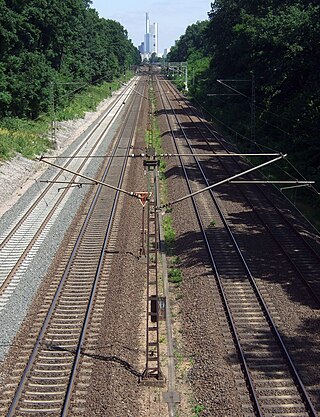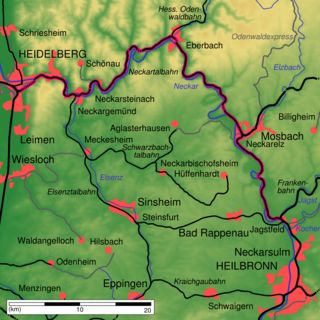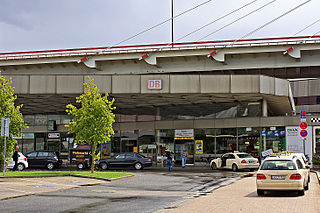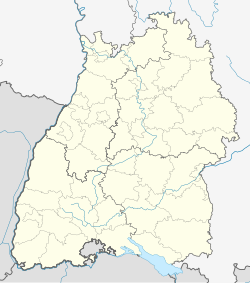
Heidelberg is a city in the German state of Baden-Württemberg, situated on the river Neckar in south-west Germany. As of the 2016 census, its population was 159,914, of which roughly a quarter consisted of students.

Karlsruhe Hauptbahnhof is a railway station in the German city of Karlsruhe. The station is classified as a Category 1 station, as it is a major hub where several railways connect.

Mannheim Hauptbahnhof is a railway station in Mannheim in the German state of Baden-Württemberg. It is the second largest traffic hub in southwestern Germany after Stuttgart Hauptbahnhof, with 658 trains a day, including 238 long-distance trains. It is also a key station in the Rhine-Neckar S-Bahn. 100,000 passengers embark, disembark or transfer between trains at the station each day. The station was modernised in 2001. It is classified by Deutsche Bahn as a category 2 station.

Darmstadt Hauptbahnhof is the main railway station in the German city Darmstadt. After Frankfurt Hbf and Wiesbaden Hbf, it is the third largest station in the state of Hesse with 35,000 passengers and 220 trains per day.

Mannheim–Frankfurt railway is a German standard gauge, electrified railway line and runs in southern Hesse and northern Baden-Württemberg between Frankfurt and Mannheim. It is also called the Riedbahn. The line runs through an area called the Hessische Ried, hence the name. The term Riedbahn was originally used for the Darmstadt–Worms railway and the two lines share the central section between Groß-Gerau and Biblis.

The Mannheim–Saarbrücken railway is a railway in the German states of Baden-Württemberg, Rhineland-Palatinate and the Saarland that runs through Ludwigshafen am Rhein, Neustadt an der Weinstraße, Kaiserslautern, Homburg and St. Ingbert. It is the most important railway line that runs through the Palatinate. It serves both passenger and freight transport and carries international traffic.

The Main-Neckar Railway is a main line railway west of the Odenwald in the Upper Rhine Plain of Germany that connects Frankfurt am Main to Heidelberg via Darmstadt, Bensheim and Weinheim. It was opened in 1846 and is one of the oldest railways in Germany.

The Neckar Valley Railway, or Neckar Valley Main Line is a railway line from Heidelberg via Eberbach and Mosbach to Bad Friedrichshall-Jagstfeld in southwestern Germany. Today it is administered by the Verkehrsverbund Rhein-Neckar and is partly worked by the Rhine-Neckar S-Bahn.

Heidelberg Hauptbahnhof is the main railway station for the city of Heidelberg. In 2005 it was used by around 42,000 passengers per day and is one of the largest passenger stations in the German state of Baden-Württemberg. The station is classified by Deutsche Bahn as a category 2 station.
The Frankfurt western stations were a group of three stations on the western edge of the former city walls of Frankfurt am Main, Germany between the modern Willy-Brandt-Platz, then the location of Gallustor and Taunustor. They were replaced by Frankfurt Hauptbahnhof in 1888.

Neustadt (Weinstr) Hauptbahnhof – called Neustadt a/d. Haardt until 1935 and from 1945 until 1950 – is the central station of in the city of Neustadt in the German state of Rhineland-Palatinate. In addition to the Hauptbahnhof, Rhine-Neckar S-Bahn services stop at Neustadt (Weinstr) Böbig halt (Haltepunkt). Mußbach station and Neustadt (Weinstr) halt, opened on 19 November 2013, are also located in Neustadt.

Ludwigshafen (Rhein) Hauptbahnhof is a railway station at Ludwigshafen am Rhein in the German state of Rhineland-Palatinate. A combination of a wedge-shaped station and a two-level interchange, the station is at the junction on the lines from Mainz and Neustadt an der Weinstrasse to Mannheim. It is classified by Deutsche Bahn as a category 2 station. The Ludwigshafen station was built in 1847 as a terminal station in the centre of modern Ludwigshafen. The current station was built in 1969 to the west of the city centre, but has not proved to be a success due to its poor location.

Bad Friedrichshall Hauptbahnhof is a regionally important junction station and a former border station in the city of Bad Friedrichshall in the German state of Baden-Württemberg. The modern Elsenz Valley Railway and Neckar Valley Railway branch from the Franconia Railway here. Until 1993 it was the starting point of the Lower Kocher Valley Railway.

Tübingen Hauptbahnhof is the largest station in the university town of Tübingen and the district of Tübingen, and a transport hub in the German state of Baden-Württemberg.

Lindau-Insel station is the largest station in the city of Lindau (Bodensee) and was its most important station until passenger service resumed at Lindau-Reutin station on December 13, 2020. In the urban area there is also Lindau-Aeschach station and Lindau-Reutin freight yard. Formerly there were also Lindau-Siebertsdorf, Lindau Langenweg, Lindau Strandbad, Schoenau, Oberreitnau and Rehlings.

Weinheim (Bergstraße) Hauptbahnhof is a station in the town of Weinheim in the German state of Baden-Württemberg. It is served by Intercity services on the Main-Neckar Railway between Frankfurt and Heidelberg/Mannheim. The Weschnitz Valley Railway (Weschnitztalbahn) to Furth in the Odenwald starts at Weinheim station. There is also a freight railway to Viernheim, the last remaining section of the former Weinheim–Worms railway.

Darmstadt South station is in the city of Darmstadt in the German state of Hesse on the Main-Neckar Railway. The station building is protected under the Hessian Monument Protection Act. It is classified by Deutsche Bahn as a category 5 station.

Neu-Edingen/Mannheim-Friedrichsfeld station is a separation station in the Mannheim district of Friedrichsfeld on the border with the municipality of Edingen-Neckarhausen in the German state of Baden-Württemberg. All rail tracks are in Mannheim, only the station building is located on the territory of the Edingen-Neckarhausen hamlet of Neu-Enghien. It is classified by Deutsche Bahn as a category 4 station. It has been served by the Rhine-Neckar S-Bahn since December 2018.

Heidelberg-Kirchheim/Rohrbach station is the second busiest station after Heidelberg Hauptbahnhof in the city of Heidelberg in the German state of Baden-Württemberg. It is classified by Deutsche Bahn (DB) as a category 4 station. It has three platforms and it is in the area where fares are set by the Verkehrsverbund Rhein-Neckar. Since December 2003, it has been almost exclusively served by services on lines S3 and S4 of the Rhine-Neckar S-Bahn.

The Klingenteichbach also called the Klingenbach or Klingengraben, is a 1.5 km long stream in Heidelberg, Baden-Württemberg, which once formed the western boundary of the town, but is now mostly covered over. It is a left tributary of the Neckar.






![Christuskirche [de]. Heidelberg 2009 -Christuskirche Heidelberg-Weststadt- by-RaBoe 001.jpg](http://upload.wikimedia.org/wikipedia/commons/thumb/f/f2/Heidelberg_2009_-Christuskirche_Heidelberg-Weststadt-_by-RaBoe_001.jpg/220px-Heidelberg_2009_-Christuskirche_Heidelberg-Weststadt-_by-RaBoe_001.jpg)



















